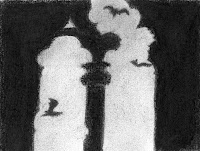
Wednesday, October 31, 2007
Happy Halloween!

Monday, October 29, 2007
Illustration Friday - Trick or Treat
 In Dallas, trees occasionally have toilet paper draped over them. I don't know if this is intended to be a trick or a treat. I have also lived in upstate New York and Los Angeles (Westwood), but I never saw toilet paper on trees until I moved to Dallas.
In Dallas, trees occasionally have toilet paper draped over them. I don't know if this is intended to be a trick or a treat. I have also lived in upstate New York and Los Angeles (Westwood), but I never saw toilet paper on trees until I moved to Dallas.This is mechanical pencil on Strathmore Bristol Vellum. I started with a photograph of a house and some trees, which I modified for the purposes of the illustration.
Sunday, October 28, 2007
Metamorphosis II

Yesterday I came across an advertisement that uses the metamorphosis of one form into another to effectively convey an advertising message. Interesting!
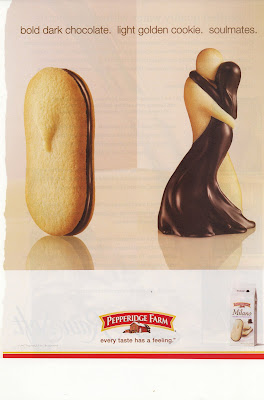
Friday, October 26, 2007
Autumn Leaf
 Autumn has finally arrived in Dallas! It has been late in coming ... as recently as October 7th my kids were swimming outside at outdoor swim parties. And I was sweating watching them! But it is nice and cool now. The leaves here are not as colorful as in the north, but they have a subtle beauty all their own. This is my favorite time of year.
Autumn has finally arrived in Dallas! It has been late in coming ... as recently as October 7th my kids were swimming outside at outdoor swim parties. And I was sweating watching them! But it is nice and cool now. The leaves here are not as colorful as in the north, but they have a subtle beauty all their own. This is my favorite time of year.Watercolor and gouache on 5" x 8" Acquarello Watercolor Studio 140 lb cold pressed paper.
Thursday, October 25, 2007
Implied Shapes

Wednesday, October 24, 2007
Tuesday, October 23, 2007
Metamorphosis

Sunday, October 21, 2007
Seven Facts About Me
Here are seven facts about me:
- I have two school-aged sons, a husband, a dog, and three cats.
- I work full-time as a software architect. (I help build software systems.)
- I am a vegetarian.
- Although I am not a Sci Fi fan, I am crazy about the show Battlestar Galactica.
- I have a Ph.D. in Management from UCLA.
- I grew up in a rural area of central New York state. We did not live on a farm, but there were (and are) many farms in the area. My father bred cows and my mother was a bookkeeper for a feed mill. Here are two plein air paintings that show the view from my parents' front yard (the house where I grew up): (1) the fields across the road and (2) the barn across the road.
- My family doesn't watch broadcast TV or cable. We have a TV, but only watch items we get from the library or Netflicks.
I am tagging:
Saturday, October 20, 2007
Stuffed Bunny
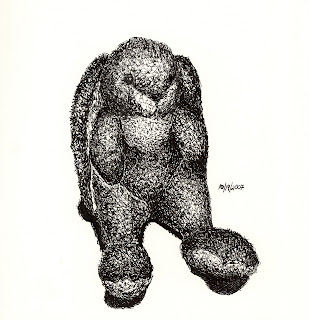
Sue Smith (Ancient Artist ) has tagged me. According to the rules, I must reveal seven facts about myself and then tag seven other bloggers. I am thinking! The seven facts will be revealed in tomorrow's post.
Thursday, October 18, 2007
Tuesday, October 16, 2007
Monday, October 15, 2007
Crosshatched Still Life
Saturday, October 13, 2007
Friday, October 12, 2007
Quartz Sphere

Thursday, October 11, 2007
Wednesday, October 10, 2007
Jars. I need Jars.
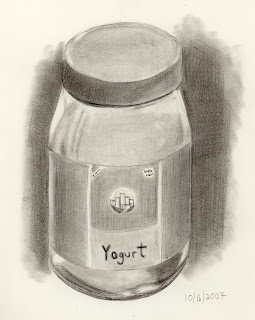
This coming Saturday is my last oil painting class, class 6 of 6. The teacher is excellent and I have learned a lot. I love oil painting and plan to start doing small paintings on my own.
Oil painting requires a lot of jars. You need jars for mixing medium (to thin paint), jars for storing small quantities of medium while painting, and jars for storing dirty medium before disposal.
The class has been quite demanding. I am exhausted by the end of each 3 hour class.
The teacher brings in a number of objects, draperies, and table coverings each week.
The first week, the teacher discussed composition and we each made our own composition using a selection of these items.
The 2nd week we drew the composition on our canvases.
The 3rd, 4th, and 5th weeks we painted. We are all sharing the same objects, so we need to frequently switch the positions of the objects. The rule is when we paint an object, we must paint the nearby objects and drapery, because the color of one influences the colors of neighbors. One stroke on an object, one stroke on a neighbor. The teacher stresses that we must learn to see nuances of colors. She says we should never put the same color on our canvas twice ... every color should be different. Wow.
The next class will be glazing.
As I go about my day now, I look for nuances of color ... I see blues in wooden fences, reds in green trees (This is Dallas ... the trees are still green), and so on. It is fun.
I have two open questions I hope to get answered at class this week:
- How do I dispose of turpentine (a hazardous material)?
- How do I keep my medium clean longer? My medium is dirty after 5 minutes of painting.
Once I have the answers, I can start painting away at home!
Monday, October 8, 2007
Letting a Drawing Draw Itself
 Here are more exercises from Keys to Drawing with Imagination.
Here are more exercises from Keys to Drawing with Imagination.To create these drawings, I made random marks on the paper with no preconceived notion of what I wanted to draw. I let the drawing emerge. The drawing told me what it wanted to be.
The first drawing below wanted to be trees. The second drawing wanted to be a dog on the way home from a birthday party. The last drawing wanted to be a scarecrow.
I used a light box to create the drawing at the top from the second drawing. The drawing at the top is a dog on the way home from a birthday party in the rain.
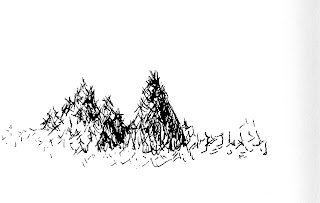
Sunday, October 7, 2007
Book Review: Drawing Realistic Textures in Pencil
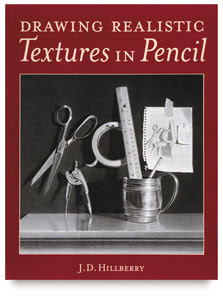 On her Making a Mark Blog, Katherine Tyrrell has invited all artists to join her October Big Drawing Book Review. I have read and done exercises from a number of art instruction books, so I thought I would join in.
On her Making a Mark Blog, Katherine Tyrrell has invited all artists to join her October Big Drawing Book Review. I have read and done exercises from a number of art instruction books, so I thought I would join in.Today I am reviewing Drawing Realistic Textures in Pencil by J.D. Hillberry, published by North Light Books in 1999 (ISBN 0-89134-868-9).
J.D. Hillberry is a self-taught artist who has discovered techniques for drawing subjects in a highly realistic way. He shares these techniques with readers in this book. Hillberry's website has examples of his work. Here is one of my drawings that utilizes his techniques.
This book will be of value to intermediate-to-advanced artists who wish to render subjects in a highly realistic manner using pencil and charcoal. I don't recommend this book for beginners, because it doesn't teach basic drawing skills.
In Chapter One, Hillberry gives a detailed explanation of the required art supplies.
In Chapter Two, Hillberry gives tips and techniques. He explains the effects that light and shadow have on form, gives tips on using value to render form, discusses blending techniques, explains how to effectively use charcoal and graphite together, and explains rubbing, indenting, and the use of frisket film.
In Chapter Three, Hillberry gives seven highly detailed step-by-step demonstrations. For example, he shows how to realistically draw glass, pitted metal, reflective metal, leather, wood, and faces. I was able to follow and apply Hillberry's step-by-step demonstrations. It tooks me a few tries to get good results, but this is because the techniques require practice, not because the instruction is poor.
In Chapter Four, Hillberry gives two more step-by-step demonstrations. One is a still life that contains a number of different textures and one is a cat on a ledge. The still life is on the cover of the book.
In order to use all of Hillberry's techniques, you will need a variety of pencils, charcoal, and miscellaneous materials such as frisket film and a chamois. You will need to make an initial investment if you don't already have a number of these items. Happily, compared to painting supplies, these materials are not expensive.
In order to get something out of any drawing book, you need to create art based on the techniques you are learning. Be forewarned that drawing in this style is very time-consuming.
I give this book 4 pencils. It does a good job at teaching what it aims to teach, for a low price. The book is attractive and the images are high-quality. Intermediate-to-advanced artists interested in creating highly realistic drawings will pick up new techniques to add to their repertoire.
I don't give the book 5 pencils because it does not meet Katherine's criterion: ... an essential book for anybody seriously interested in drawing and/or learning more about drawing. The book is not for those who are primarily interested in painterly approaches to drawing. One can create outstanding drawings without ever using the techniques discussed in this book. So I cannot say everyone needs to read this book.
Saturday, October 6, 2007
Illustration Friday - Open

Friday, October 5, 2007
Crosshatched Mug
 I love well-executed crosshatching but am not very good at it. Here is some practice from yesterday. I used a 4B pencil ... I am thinking a slightly harder pencil might give finer results. Experimentation doesn't always lead to good results. It is tempting to stay in one's comfort zone and do things the way one has always done them. But growth as artist requires experimenting, enjoying the process, and not getting too wrapped up in each and every result.
I love well-executed crosshatching but am not very good at it. Here is some practice from yesterday. I used a 4B pencil ... I am thinking a slightly harder pencil might give finer results. Experimentation doesn't always lead to good results. It is tempting to stay in one's comfort zone and do things the way one has always done them. But growth as artist requires experimenting, enjoying the process, and not getting too wrapped up in each and every result.Thursday, October 4, 2007
Wednesday, October 3, 2007
Glass Vase

Tuesday, October 2, 2007
Pewter Candlestick Holder











